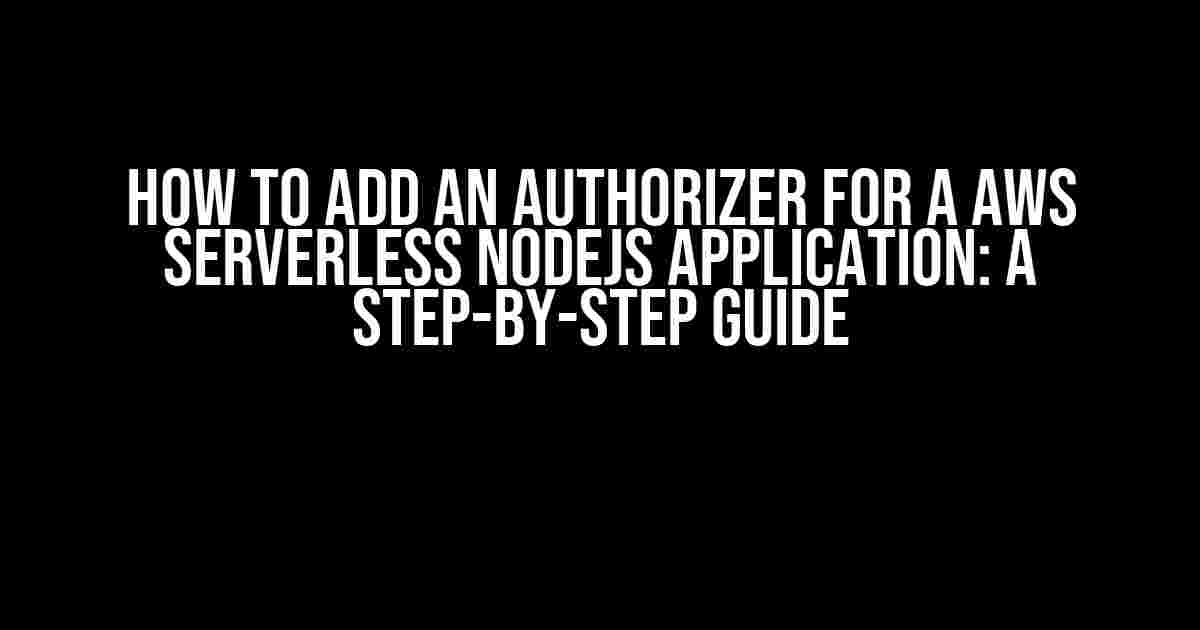As the popularity of serverless applications continues to grow, so does the need for robust security measures to protect sensitive data. One crucial aspect of securing your AWS serverless NodeJS application is implementing an authorizer. In this article, we’ll delve into the world of authorizers and provide a comprehensive guide on how to add one to your AWS serverless NodeJS application.
What is an Authorizer?
An authorizer is a Lambda function that verifies and validates incoming requests to your API. It acts as a gatekeeper, ensuring that only authorized users or services can access your application’s resources. In the context of AWS serverless NodeJS applications, an authorizer is used to authenticate and authorize requests made to your API Gateway.
Why Do I Need an Authorizer?
Without an authorizer, your API is vulnerable to unauthorized access, which can lead to:
- Security breaches: Unauthorized access can result in sensitive data exposure or manipulation.
- Data tampering: Malicious actors can modify or delete data without permission.
- Denial of Service (DoS) attacks: Unchecked requests can overwhelm your API, causing performance issues or even downtime.
In addition to security benefits, an authorizer also enables you to:
- Implement role-based access control (RBAC)
- Enforce rate limiting and quotas
- Log and monitor requests for auditing and analytics
Step 1: Create an Authorizer Lambda Function
To create an authorizer Lambda function, follow these steps:
- Log in to the AWS Management Console and navigate to the Lambda dashboard.
- Click “Create function” and choose “Author from scratch”.
- Select “Node.js” as the runtime and give your function a name (e.g., “my-authorizer”).
- Set the handler to “index.handler” and create a new role or choose an existing one.
exports.handler = async (event) => {
// Your authorization logic goes here
return {
principalId: 'user',
policyDocument: {
Version: '2012-10-17',
Statement: [
{
Action: 'execute-api',
Effect: 'Allow',
Resource: 'arn:aws:execute-api:*:*:*'
}
]
}
};
};
In this example, we’re returning a simple policy document that allows the `execute-api` action. You’ll need to modify this to fit your specific use case.
Step 2: Configure API Gateway to Use the Authorizer
To configure API Gateway to use your authorizer, follow these steps:
- Navigate to the API Gateway dashboard and select the API you want to secure.
- Click “Authorizers” in the left-hand menu and then click “Create Authorizer”.
- Select “Lambda function” as the authorizer type and choose the Lambda function you created earlier.
- Set the ” Identity sources” to “Authorization” and click “Create Authorizer”.
| Field | Description |
|---|---|
| Authorizer Name | The name of your authorizer (e.g., “my-authorizer”) |
| Lambda Function | The ARN of your Lambda function |
| Identity Sources | The source of the identity token (in this case, the “Authorization” header) |
Step 3: Update Your API Gateway Method to Use the Authorizer
To update your API Gateway method to use the authorizer, follow these steps:
- Navigate to the API Gateway dashboard and select the API you want to secure.
- Click “Resources” in the left-hand menu and then select the method you want to secure (e.g., “GET /users”).
- Click the “Method Request” section and then click the “Authorization” tab.
- Select “Custom Authorizer” and choose the authorizer you created earlier.
That’s it! Your API Gateway method is now secured with an authorizer.
Testing Your Authorizer
To test your authorizer, you’ll need to make a request to your API Gateway method with a valid authorization token. You can use tools like Postman or cURL to send a request.
curl -X GET \
https://your-api.execute-api.us-east-1.amazonaws.com/dev/users \
-H 'Authorization: Bearer YOUR_VALID_TOKEN'
If your authorizer is configured correctly, you should receive a successful response. If not, check your Lambda function’s CloudWatch logs for errors.
Conclusion
In this article, we’ve covered the importance of implementing an authorizer for your AWS serverless NodeJS application. By following these steps, you’ve successfully added an authorizer to your API Gateway method, ensuring that only authorized requests can access your application’s resources.
Remember to customize your authorizer Lambda function to fit your specific use case, and don’t hesitate to reach out if you have any questions or need further assistance.
Happy coding, and secure coding!
Frequently Asked Question
Confused about adding an authorizer to your AWS Serverless NodeJS application? Don’t worry, we’ve got you covered!
What is an authorizer in AWS Serverless and why do I need one?
An authorizer is a function that validates the identity of a user or service before allowing access to your Serverless application. You need an authorizer to ensure that only authorized users or services can invoke your functions, providing an additional layer of security and control.
How do I create an authorizer for my AWS Serverless NodeJS application?
To create an authorizer, you need to create a new Lambda function with the desired authentication logic. Then, update your Serverless function to include the authorizer function ARN in the `authorizer` section of your `serverless.yml` file.
What are the different types of authorizers available in AWS Serverless?
There are two types of authorizers in AWS Serverless: Token-based authorizers and Request-based authorizers. Token-based authorizers validate a token passed in the request headers, while Request-based authorizers validate the request context, such as the request headers and query parameters.
How do I configure my authorizer to authenticate using AWS Cognito User Pools?
To authenticate using AWS Cognito User Pools, you need to create a Cognito User Pool and configure your authorizer to validate the ID token issued by Cognito. You can do this by passing the User Pool ID and App Client ID in the `authorizer` section of your `serverless.yml` file.
Can I use multiple authorizers for my AWS Serverless NodeJS application?
Yes, you can use multiple authorizers for your AWS Serverless NodeJS application. This can be useful if you need to support multiple authentication mechanisms or if you want to validate different aspects of the request. You can configure multiple authorizers in the `authorizer` section of your `serverless.yml` file.
